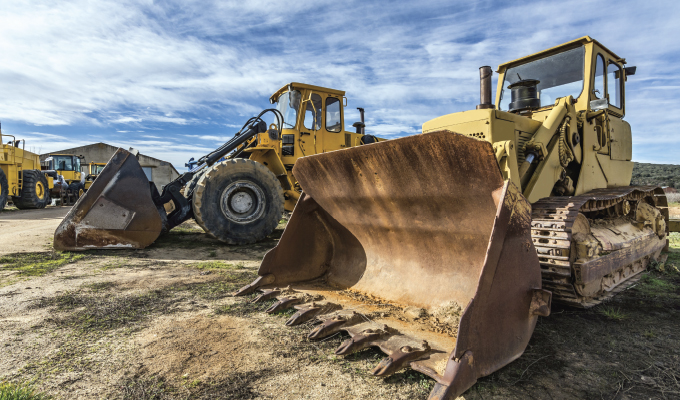To upgrade or not to upgrade your equipment—it’s a question that concerns many small business owners but is particularly relevant to contractors. It seems there is always some new and improved spin on jobsite mainstays, from project management software to power tools to heavy machinery. But constantly trying to keep pace with the latest and greatest in equipment can have a big impact on the bottom line—in some cases, only to see an investment become obsolete in just a few years.
On the other hand, outdated equipment can limit your business’s potential, hurt your reputation, or even be dangerous. So how do you know when it’s time to upgrade your equipment, and how can you manage cash flow to lessen the burden? Here are some practical tips to keep in mind when considering your next equipment purchase.
1. ASSESS YOUR BUSINESS’S EQUIPMENT
The first step to determining if you need to invest in new equipment is to take stock of your current equipment. Look at how much you’re spending on just maintaining old equipment, and the productivity lost as a result. If you’re going to have to replace that old truck in another year or two, it might be more cost effective to do so now. It might also be safer.
According to OSHA, the construction industry accounts for 20% of workplace deaths, and relying on outdated power tools, vehicles or heavy machinery can put your business at risk for sidelined employees or even lawsuits. Of course, there’s also your reputation to consider, with customers as well as with your employees. Your equipment is often the most visible part of a jobsite, which means it reflects on your business. And if you want to hold onto valued employees, you can’t expect them to use unreliable or obsolete equipment.
But even if your equipment isn’t especially old or requiring constant upkeep, it’s worth assessing whether new purchases could benefit your business. Also ask yourself if there are new purchases that would improve your team’s efficiency or your customers’ satisfaction, like software that could automate project management, streamline communication and workflows, and keep customers informed.
Investing in new equipment can also generate new business opportunities, either by allowing you to take on new kinds of work or more work.
Before you take the plunge into upgrading your equipment, the most important thing is knowing why you’re making this investment and how it will benefit your business. If you do decide it’s time to level up, your next step is to figure out the most cost-effective way of doing it.
2. MAKE A FINANCIAL PLAN
When it comes to paying for new equipment, you have a few options: financing and leasing. Each has its pros and cons, and which route you take depends on your specific needs.
Option 1: Equipment Financing: An equipment loan is a popular option and can be used for everything from office furniture and computers to trucks and excavators. Before applying for equipment financing, you should weigh the short- and long-term benefits. If the equipment will bring in revenue–or another, more intangible benefit–greater than your monthly payment, then financing might be a great option. However, also think about the lifespan of the equipment. Will it continue to be useful for a while after it’s paid off? Other benefits include:
- Own the equipment: Once the loan is paid off, the equipment will be yours to use and depending on the equipment it can even be leveraged as collateral to borrow against, or even resell.
- Easier to qualify: Because the equipment is used as collateral, your credit score will not be as much of a consideration. Also, in many cases, you won’t be held personally responsible for repaying the loan.
- Tax benefits: You can often fully deduct the cost of newly purchased equipment. In other cases, you can take depreciation deductions.
- Build credit: By building a history of on-time loan payments, you can increase your credit score and make it easier to qualify for other types of business loans.
Cons might require an initial down payment and may have higher interest rates than other types of loans.
Option 2: Equipment Lease: With a lease, you agree to rent the equipment for a period of time. At the end of the lease, you return the equipment—although you will usually have the option of renewing the lease or purchasing the equipment. Some pros include the possibility of being more affordable. The monthly payment might be lower than a comparable loan and rarely requires a down payment. This could be useful if the equipment could become obsolete in the near future. And, it’s tax deductible.
Some of the cons include fewer options; you won’t have the full range of equipment to choose from; additional fees (pay close attention to your contract. You might be held responsible for insurance, maintenance, and other fees on top of your lease payments.
CLOSING THOUGHT
With new equipment, it’s time to start reaping the rewards. If you’ve made your business more efficient, be sure to inform your customers of the benefits. Alternatively, your new capabilities might allow you to take on more complicated, higher-end work for which you can charge more. Don’t forget to advertise your new services and spread the word to potential employees as well to attract in-demand candidates. If invested wisely, new equipment can be a boost to your business that will pay off for years to come.
About the Author:
Gianpierre Raicovi joined Lendio in October 2015, bringing a little over 3½ years of financial industry experience to his chief sales officer role. In the nearly 7 years he’s been with Lendio, Gianpierre has experience in all strategic and functional aspects of sales but finds building teams and culture most compelling. Gianpierre leads all efforts that encompass SMB Success. For more, visit www.lendio.com.
Modern Contractor Solutions, October 2022
Did you enjoy this article?
Subscribe to the FREE Digital Edition of Modern Contractor Solutions magazine.



